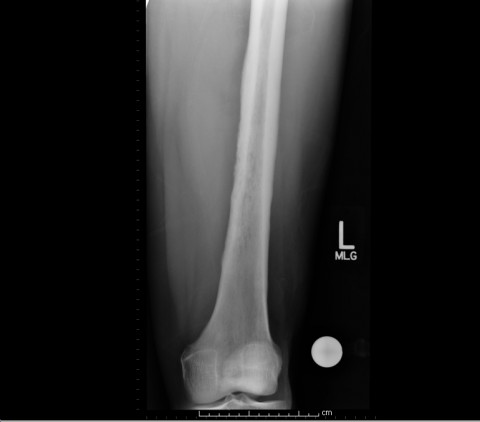Case Identification
Case ID Number
Tumor Type
Body region
Position within the bone
Periosteal reaction
Benign or Malignant
Clinical case information
Case presentation
The symptoms have been going on for 18 months. He has been diagnosed and treated by multiple providers for tendinitis, sacroiliitis, and lumbar disc disease. Recently, he has started having soaking night sweats.
Radiological findings:
There is a large permeative lesion in the distal diaphysis of the left femur, with a very minimal periosteal reaction. The MRI shows a large mass surrounding the shaft of the femur, as well as permeating the marrow space, which has no visible calcification on the x-rays. The mass extends through the intramedullary portion of the femur for distance of 27 cm, reaching almost to the level of the physeal scar distally. The maximum transverse diameter of the mass is 6.5 cm. There is permeative destruction of the posterior medial cortex of the femur, but no fracture is evident. A CT scan of the chest abdomen and pelvis shows that there are sclerotic lesions adjacent to the left sacroiliac joint and in the right posterior iliac crest. Full interpretation of the CT scan of the chest, abdomen and pelvis is pending. A chest x-ray shows no abnormality.
Laboratory results:
pending.
Differential Diagnosis
This is an aggressive appearing lesion, the patient was almost 60, with a long history of symptoms, including soaking night sweats. There are sclerotic bone lesions in the pelvis. There is no definite abdominal or chest mass. Possibilities include primary lymphoma of bone, Ewing sarcoma, other primary sarcoma.
Further Work Up Needed:
The patient will require a biopsy and possibly a bone marrow analysis. Other imaging or laboratory workup may be necessary depending on the results of the biopsy.
Pathology results:
pending.
Special Features of this Case:
This case is notable for the very long duration of symptoms, the multitude of incorrect diagnoses the patient has received, and the long delay in diagnosis.
Imagen

Case ID Number
Image Types
Image modality
Tumor Name
Example Image
yes
Benign or Malignant
Bone name
Location in the bone
periosteal reaction
position within the bone
Tumor behavior
Tumor density









